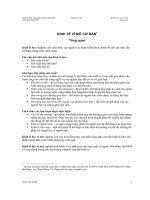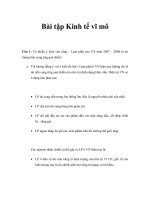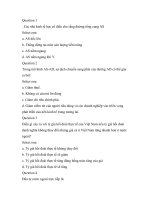- Trang chủ >>
- Đại cương >>
- Kinh tế vĩ mô
Economic growth (KINH tế vĩ mô 1)
Bạn đang xem bản rút gọn của tài liệu. Xem và tải ngay bản đầy đủ của tài liệu tại đây (440.48 KB, 25 trang )
Chapter 3 - Economic
growth
Content
1 Definition, computing method and
implications of economic growth
2 Factors decide economic growth in the long
run
3 Theories of economic growth
4 Policies to promote economic growth
1 Definition, computing method and
implications of economic growth
Definition
Economic growth is the increase in the market value
of the goods and services produced by an economy over
time. It is conventionally measured as the percent rate
of increase in real gross domestic product, or real GDP
To reflect more accurately about living standard of each
person in country, economists use the growth of the
ratio of GDP to population (GDP per capita), which is
also called income per capita
An increase in per capita income is referred to
as intensive growth. GDP growth caused only by
increases in population or territory is called extensive
growth
1 Definition, computing method and
implications of economic growth
Computing
method
+ Absolute growth (in number)
+ Relative growth (in percentage)
Yt Yt 1
100%
Using total real GDPg t
Yt 1
g pct
Using real GDP per capita
yt yt 1
100%
yt 1
1 Definition, computing method and
implications of economic growth
+ Average growth
y n y 0 (1 g a )
n
yn
g a n
1
y0
yn GDP at the end of
period
y0 GDP in the beginning of
period
ga average growth in
Rule of thumb: rule of 70
A way to estimate the number of years it takes
for a certain variable to double. The rule of 70
states that in order to estimate the number of
years for a variable to double, take the number
70 and divide it by the growth rate of the variable
(70/g). This rule is commonly used with an
annual compound interest rate to quickly
determine how long it would take to double your
money.
If the growth rate is greater than 4% we use 72
for dividing (rule of 72)
Similarly, we have rule of 110 for triple growth
and rule of 140 for quadruple growth
1 Definition, computing method and
implications of economic growth
Implications
Enhance people’s income, thereby
improving living standard
Create jobs, mitigate unemployment
(Okun’s law)
Provide finance to strengthen national
security, political credibility
With low income countries, high economic
growth rate helps these country to catch up
high income ones
The variety of growth experiences
Country
Period
Real GDP per
person
at beginning of
period
Real GDP per
person
at end of period
Growth
rate
(per year)
Japan
Brazil
China
Mexico
Germany
Canada
Argentina
United States
India
United
Kingdom
Indonesia
Bangladesh
Pakistan
1890–
2006
1900–
2006
1900–
2006
1900–
2006
1870–
2006
1870–
2006
1900–
2006
1870–
2006
$1,408
729
670
1,085
2,045
2,224
2,147
3,752
632
4,502
834
583
690
$33,150
8,880
7,740
11,410
31,830
34,610
15,390
44,260
3,800
35,580
3,950
2,340
2,500
2.76%
2.39
2.34
2.24
2.04
2.04
1.88
1.83
1.71
1.53
1.48
1.32
1.22
2 Factors decides economic growth
in the long run
Economic growth in long run means the
increase of productivity (quantity of goods
and services produced from each unit of
labor input).
Productivity is so important because it is the
key determinant of living standards (an
economy’s income is the economy’s output)
The question is how productivity is
determined
2 Factors decides economic growth
in the long run
How productivity is determined
Physical capital (K)
Stock of equipment and structures
Used to produce goods and services
Human capital (H)
Knowledge and skills that workers acquire through
education, training, and experience
Natural resources (R)
Inputs into the production of goods and services
Provided by nature, such as land, rivers, and
mineral deposits
Technological knowledge (T)
Society’s understanding of the best ways to
produce goods and services
3 Theories of economic
growth
Classical theory
Land plays an important role for
economic growth
Production expansion depends on savings of
capitalist
Savings of capitalist depends on profit
Profit depends on production cost
Production cost depends on labor cost
Labor cost depends on food price
Food price depends on land area
3 Theories of economic growth
Keynesian
theory – Harrod Domar model
Capital accumulation plays an important role
for economic growth
According to Harrod – Domar model
g - economic growth, s - national saving rate, k ICOR (incremental capital output ratio) index
K
ICOR
Y
3 Theories of economic growth
Keynesian theory – Harrod Domar model
Conclusions drawn by Harrod - Domar model:
Economic growth rate (g) has positive
relationship with saving rate (s) and
negative relationship with ICOR index (k)
Due to constant k in short run, s is the most
determinant of g
There is a trade off between current
consumption and future consumption
3 Theories of economic growth
Neoclassical theory – Solow model
We build Solow model from constant return
production function Y = f (K,L)
We transform the function:
1
1
1
y Y . f ( K . , L. ) f ( k )
L
L
L
y – products per capita or income per capita
k – capital per capita
3 Theories of economic growth
Neoclassical theory – Solow model
Graph illustrating the relationship between k
and y
3 Theories of economic growth
Neoclassical theory – Solow model
Two key questions from the graph
Why pace of output increase becomes slow
(slop of production curve)?
How economy overcomes steady state?
Answer two questions
Slow pace of output increase due to
diminishing marginal return of capital
To overcome steady state, it requires
technological advances
3 Theories of economic growth
Neoclassical theory – Solow model
However technological advance in Solow
model is given variable (exogenous variable).
Therefore, Solow model is also called
exogenous growth model.
3 Theories of economic growth
Neoclassical theory – Solow model
Catch – up effect (convergence)
3 Theories of economic growth
Neoclassical theory – Solow model
Conclusions drawn by Solow model:
The role of savings for economic growth
Capital accumulation is good for short run
economic growth
Technology is the determinant of long run
economic growth
3 Theories of economic growth
Modern theory – endogenous model
Later economist (Paul Romer, Grossman,
Mankiw…) proposed economic growth model
in which technological advances are
determined by R&D investment, government
spending for education, number of workers in
knowledge producing area…
Because now technological advances are
internally decided then modern theory is also
called as endogenous growth model
4 Policy to promote economic growth
Saving and investment: Raise future productivity
Invest more current resources in the
production of capital
Trade-off: Devote fewer resources to produce
goods and services for current consumption
Investment from abroad: Another way for a
country to invest in new capital
Foreign direct investment: Capital investment
that is owned and operated by a foreign entity
Foreign portfolio investment: Investment
financed with foreign money but operated by
domestic residents
4 Policy to promote economic growth
Education: Investment in human capital
Gap between wages of educated and uneducated
workers
Opportunity cost: wages forgone
Conveys positive externality
Brain drain (problem for poor countries)
Health and nutrition: Healthier workers – more productive
The right investments in the health of the population:
One way for a nation to increase productivity and raise
living standards
Historical trends of long-run economic growth:
Improved health - from better nutrition and Taller
workers – higher wages – better productivity
4 Policy to promote economic growth
Property rights and political stability: Create
favorable institutions
Protect property rights: Ability of people
to exercise authority over the resources
they own
Promote political stability
Free trade: Utilize national advantages
Inward-oriented policies: avoid
interaction with the rest of the world
Outward-oriented policies: integrate into
the world economy
4 Policy to promote economic growth
Research and development : Knowledge – public good that
enhances technology
Research Institutes or other science programs funded by
government
Research grants
Tax breaks
Patent system
Population growth: Large population create both
advantages and disadvantages
Stretching natural resources
Diluting the capital stock
Reduces GDP per worker
But
Promoting technological progress
Large labor force
More consumers
Key concepts
Economic growth
Income per capita
Living standard
Rule of 70
Human capital, Physical capital, Natural
resources, Technology advance
Classical theory
Keynesian theory, Harrod – Domar model
Neo-classical theory, Solow model
Steady state
Endogenous model
R&D









